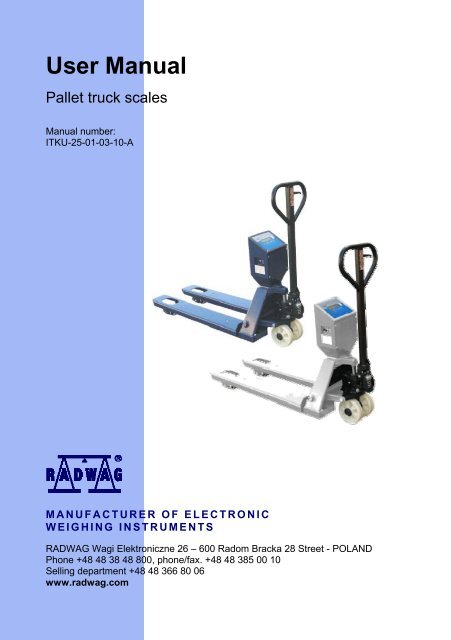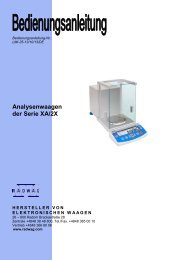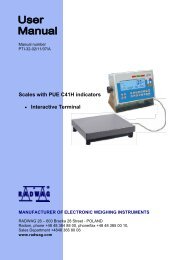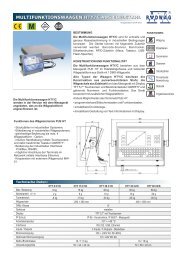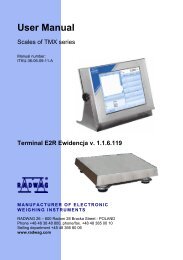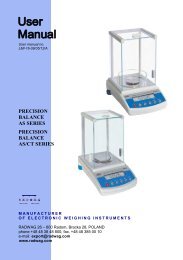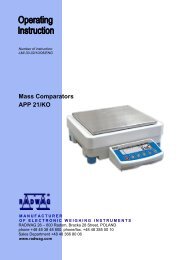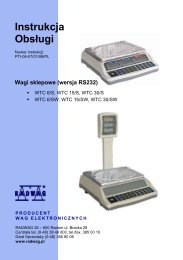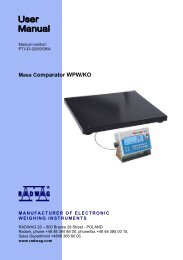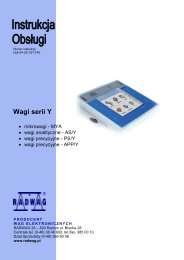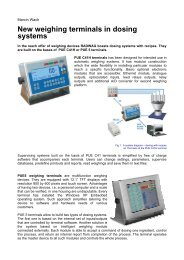Manual instruction - Pallet truck scales - Radwag
Manual instruction - Pallet truck scales - Radwag
Manual instruction - Pallet truck scales - Radwag
Create successful ePaper yourself
Turn your PDF publications into a flip-book with our unique Google optimized e-Paper software.
User <strong>Manual</strong><br />
<strong>Pallet</strong> <strong>truck</strong> <strong>scales</strong><br />
<strong>Manual</strong> number:<br />
ITKU-25-01-03-10-A<br />
MANUFACTURER OF ELECTRONIC<br />
WEIGHING INSTRUMENTS<br />
RADWAG Wagi Elektroniczne 26 – 600 Radom Bracka 28 Street - POLAND<br />
Phone +48 48 38 48 800, phone/fax. +48 48 385 00 10<br />
Selling department +48 48 366 80 06<br />
www.radwag.com
MARCH 2010<br />
- 2 -
TABLE OF CONTENTS<br />
1. INTENDED USE .................................................................................................................... 5<br />
2. PRECAUTIONS..................................................................................................................... 6<br />
2.1. General comments......................................................................................................... 6<br />
2.2. Operation remarks for weighing pallet tracks................................................................. 6<br />
2.3. Accumulator / battery pack............................................................................................. 8<br />
3. CONDITIONS OF SAFE OPARATION.................................................................................. 9<br />
4. GETTING STARTED ............................................................................................................. 9<br />
5. KEYPAD .............................................................................................................................. 10<br />
6. KEYS’ FUNCTIONS ............................................................................................................ 10<br />
7. INSCRIPTIONS ON THE DISPLAY .................................................................................... 11<br />
8. USER MENU ....................................................................................................................... 12<br />
8.1. Submenus .................................................................................................................... 12<br />
8.2. Browsing user menu .................................................................................................... 13<br />
8.2.1. Keypad .............................................................................................................. 13<br />
8.2.2. Return to the weighing mode ............................................................................ 13<br />
9. WEIGHING .......................................................................................................................... 14<br />
9.1. Tarring.......................................................................................................................... 14<br />
9.2. Inscribing tare value ..................................................................................................... 14<br />
9.3. Zeroing ......................................................................................................................... 15<br />
9.4. Weighings in two ranges .............................................................................................. 16<br />
9.5. Selection of basic weight unit....................................................................................... 16<br />
9.6. Temporarily selected unit ............................................................................................. 17<br />
10. MAIN PARAMETERS........................................................................................................ 18<br />
10.1. Setting a filtering level ............................................................................................... 18<br />
10.2. Median filter ............................................................................................................... 19<br />
10.3. Autozero function....................................................................................................... 20<br />
10.4. Tare function.............................................................................................................. 21<br />
11. RS 232 PARAMETERS ..................................................................................................... 22<br />
11.1. Printout type............................................................................................................... 22<br />
11.2. Minimal mass threshold............................................................................................. 23<br />
11.3. Baud rate ................................................................................................................... 24<br />
11.4. Serial transmission parameters ................................................................................. 25<br />
12. OTHER PARAMETERS .................................................................................................... 26<br />
12.1. Backlight function ...................................................................................................... 26<br />
12.1.1. Backlight for supplying from mains.................................................................. 26<br />
12.1.2. Backlight for supplying from batteries ............................................................. 27<br />
12.2. “Beep” signal – after pressing a key .......................................................................... 28<br />
12.3. Automatic switch-off .................................................................................................. 28<br />
12.4. Batter y voltage level check........................................................................................ 29<br />
12.4.1. Checking the batteries..................................................................................... 30<br />
12.4.2. Battery discharge pictogram............................................................................ 30<br />
12.4.3. Accumulator charging option........................................................................... 31<br />
13. WORK MODES ................................................................................................................. 32<br />
13.1. Setting accessibility of operation modes ................................................................... 32<br />
13.2. Selecting quantity of operation modes ...................................................................... 33<br />
13.3. Counting pieces of the same mass ........................................................................... 34<br />
13.4. +/- control referring to the inscribed standard mass .................................................. 36<br />
- 3 -
13.5. Control of % deviation referring to the inscribed standard mass ............................... 38<br />
13.5.1. Standard mass determined by its weighing..................................................... 38<br />
13.5.2. Mass of standard inscribed to scale memory .................................................. 39<br />
13.6. Automatic tare ........................................................................................................... 40<br />
13.7. Measurement max force on the pan – latch .............................................................. 41<br />
13.8. Totalizing ................................................................................................................... 41<br />
13.8.1. Enabling the work mode.................................................................................. 42<br />
13.8.2. Totalizing procedure........................................................................................ 42<br />
13.8.3. Memory of the last value of sum of weighed goods ........................................ 43<br />
13.8.4. Return to weighing .......................................................................................... 44<br />
13.9. Weighing animals ...................................................................................................... 45<br />
13.10. Tare memory............................................................................................................ 46<br />
13.10.1. Entering the tare value to the scale memory ................................................ 46<br />
13.10.2. Selecting a tare value from the memory ....................................................... 48<br />
14. USER CALIBRATION ....................................................................................................... 49<br />
14.1. Calibration ................................................................................................................. 49<br />
14.2. Start mass adjustment............................................................................................... 51<br />
15. COOPERATION WITH PRINTER ..................................................................................... 52<br />
16. COOPERATION WITH COMPUTER................................................................................. 53<br />
17. COMMUNICATION PROTOCOL ...................................................................................... 54<br />
17.1. General information ................................................................................................... 54<br />
17.2. A set of commands for RS interfaces ........................................................................ 54<br />
17.3. Respond message format ......................................................................................... 55<br />
17.4. Command’s description ............................................................................................. 55<br />
17.4.1. Zeroing ............................................................................................................ 55<br />
17.4.2. Tarring ............................................................................................................. 55<br />
17.4.3. Get tare value.................................................................................................. 56<br />
17.4.4. Send the stable result in basic unit.................................................................. 56<br />
17.4.5. Send the result immediately in basic unit ........................................................ 57<br />
17.4.6. Send the stable result in current unit............................................................... 57<br />
17.4.7. Send the result immediately in current unit ..................................................... 58<br />
17.4.8. Switch on continuous transmission in basic unit ............................................. 59<br />
17.4.9. Switch off continuous transmission in basic unit ............................................. 59<br />
17.4.10. Switch on continuous transmission in current unit........................................ 59<br />
17.4.11. Switch off continuous transmission in current unit........................................ 60<br />
17.4.12. Send all implemented commands................................................................. 60<br />
17.5. <strong>Manual</strong> printouts / automatic printouts....................................................................... 60<br />
17.6. Continuous transmission ........................................................................................... 61<br />
17.7. Configuring printouts ................................................................................................. 62<br />
18. ERROR COMMANDS........................................................................................................ 62<br />
19. TROUBLE SHOOTING ..................................................................................................... 63<br />
20. TECHNICAL PARAMETERS ............................................................................................ 64<br />
21. ADDITIONAL EQUIPMENT............................................................................................... 64<br />
- 4 -
1. INTENDED USE<br />
WWC <strong>scales</strong> with a hydraulic <strong>truck</strong> with hoist are applied to caring pallets<br />
with loads with a possibility of weighings the carried loads. Tarring in the<br />
whole measuring range allows to measure the net mass. Using WWC<br />
scale allows us to shorten the cycle of receiving goods in a warehouse.<br />
Functions:<br />
- backlight of display<br />
- level of filtration<br />
- autozero function<br />
- setting baud rate of transmission<br />
- continuous data transmission for RS 232<br />
- automatic operation for RS 232<br />
- designed printouts<br />
- designation minimum mass for function operating<br />
- counting pieces<br />
- +/- mass control<br />
- percentage deviation from standard mass<br />
- latch of maximum scale indication<br />
- automatic tare<br />
- memory of tare<br />
- Memory of 9 tare values<br />
- inscribing tare value<br />
- automatic scale switch-off<br />
- user calibration<br />
- Totalizing<br />
- Weighing animals<br />
User functions may have attribute of accessibility. For this reason it is<br />
possible to adjust scale to individual needs to provide access to only these<br />
functions which are currently needed. Attribute determination accessible /<br />
inaccessible is possible in user menu and described in further part of<br />
manual.<br />
- 5 -
2. PRECAUTIONS<br />
2.1. General comments<br />
A. Please, read carefully this user manual before and use the device<br />
according to its intended use.<br />
B. Devices that are to be withdrawn from usage should be sent back to<br />
the producer or in case of own utilization do it according to the law.<br />
2.2. Operation remarks for weighing pallet tracks<br />
During transportation the <strong>truck</strong> should be placed in upright position with<br />
lowered down and protected against moving. Different positioning of pallet<br />
<strong>truck</strong> scale can cause creation of air pocketing of hydraulic set. In case of<br />
air pocketing of the hydraulic set, please:<br />
- Place the steering handle in position „ LOWER”,<br />
- Pump with drawbar the hydraulic set,<br />
- During pumping please do not reach the highest and lowest<br />
positions of the beams.<br />
The pallet <strong>truck</strong> scale is designed for horizontal moving and mass<br />
measuring of loads on smooth, not bumpy, surfaces. Using the pallet<br />
<strong>truck</strong> scale on bumpy and uneven surfaces may cause premature worn<br />
out of the suspension and wheels of the scale. It also endangers the<br />
mechanical parts of the scale to mechanical, or dynamical overloading<br />
of the load cells.<br />
- 6 -
Measured load should be placed uniformly on the pallets towards its<br />
symmetric centre. A pallet should be placed on forks of the scale In<br />
such a way that its centre is close to the symmetric centre of the scale<br />
forks. Do not overload the scale above its max capacity!<br />
It is not allowed to place the load on the forks dynamically. The load<br />
should be put on the pallet <strong>truck</strong> scale gently without strokes. If the<br />
loads are placed rapidly, than the load cells may get damaged.<br />
The pallet <strong>truck</strong> scale is designed for manual operation. Do not<br />
tow or push the pallet <strong>truck</strong> scale with mechanical vehicles.<br />
Please check the oil level at least every 6 months. If necessary please<br />
fill the lack of oil with hydraulic oil ISO VG32, with viscosity 30 cSt at<br />
40°C. By everyday usage of the scale, please pay special attention<br />
to keep the wheels, axles and levels not blocked.<br />
After finish of operation, please leave the beams in lowered position<br />
and unloaded.<br />
In order to keep the pallet <strong>truck</strong> scale in good condition, it is necessary<br />
to perform periodical maintenance, i.e. once a month. The maintenance<br />
activities cover cleaning of pallet <strong>truck</strong> scale, and general conservation<br />
against rust. Oiling of the scale should be performed every 100h of<br />
operation. Oil In the oil tank should be changed every 600h of operation.<br />
- 7 -
When changing the oil, please flush the hydraulic set and fil lit with<br />
hydraulic oil with proper viscosity. Instead of hydraulic oil ISO VG32,<br />
it is allowable to use oil with viscosity 30 cSt in 40°C.<br />
It is extremely necessary to keep the pallet <strong>truck</strong> scale in clean condition,<br />
so that any foreign matter does not get between the beams of the scale<br />
and weighing forks (foreign matters in this places may limit the movement<br />
of load cells and so the measuring result may have an error).<br />
2.3. Accumulator / battery pack<br />
WWC <strong>scales</strong> are devices designed to be supplied from SLA accumulators<br />
(Sealed lead acid type) 6V o and capacity 3 to 4Ah charged while<br />
connected to mains without stopping operation.<br />
The device connected to mains inteligently monitors the battery state and<br />
charges it if possible. After sudden lack of power supply from the mains<br />
the device automatically switches to accumulator without breaking<br />
operation.<br />
In case of an elongated storage period in low<br />
temperatures, it is not allowed the full discharge<br />
of the accompanied batteries.<br />
A worn out accumulator can be exchanged to a new one<br />
by the authorized service of the manufacturer.<br />
The equipment including accumulators does not belong<br />
to your regular household waste. The European legislation<br />
requires that electric and electronic equipment be collected<br />
and disposed separately from other communal waste with<br />
the aim of being recycled.<br />
Notice:<br />
Some symbols on accumulators identify harmful elements/compounds:<br />
Pb = lead,<br />
Cd = cadmium,<br />
Hg = mercury.<br />
- 8 -
3. CONDITIONS OF SAFE OPARATION<br />
• Switch off the pallet <strong>truck</strong> scale before installation, servicing, clearing<br />
or change of fuse, not applying his rule may cause body or instrument<br />
damage,<br />
• Do not use the scale when close to water, e.g. pools, water sinks,<br />
• laundries or in humid condition,<br />
• Pulling the pallet <strong>truck</strong> scale should always be done with handle of the<br />
scale. This handle eases the movement of the pallet <strong>truck</strong> scale and<br />
lifting of the forks. The hydraulic set and other parts are protected<br />
when scale is used properly,<br />
• User should read all the manuals and cautions before using the<br />
instrument,<br />
• <strong>Pallet</strong> <strong>truck</strong> scale should not be used unless the user has read all<br />
the manuals and has been trained to use the instrument,<br />
• Do not carry people on the pallet <strong>truck</strong> scale,<br />
• During transportation of loads on the pallet <strong>truck</strong> scale, other people<br />
should not come too close to the instrument,<br />
• The load should be placed centrally on the weighing forks,<br />
• Do not overload the pallet <strong>truck</strong> scale,<br />
• <strong>Pallet</strong> <strong>truck</strong> scale should operate far from fire sources,<br />
• Do not use other devices to put the load on the forks of the pallet<br />
<strong>truck</strong> scale.<br />
4. GETTING STARTED<br />
• Turn the device on using the key – keep pressing<br />
the key for about 0.5 sec,<br />
• Wait for the test completion,<br />
• Then you will see zero indication and pictograms:<br />
kg<br />
- zero indication<br />
- stable result<br />
- weight unit<br />
• If the indication is not zero press<br />
key.<br />
- 9 -
5. KEYPAD<br />
6. KEYS’ FUNCTIONS<br />
Switching on/off<br />
Function key (operation mode selection)<br />
Sending a weighing result to RS232<br />
Zeroing<br />
Tarring<br />
Notice:<br />
After pressing + keys’ functions changes. The way of operation<br />
in this mode is described in details further in this manual.<br />
- 10 -
7. INSCRIPTIONS ON THE DISPLAY<br />
No Text string Description<br />
1. FIL Filter level<br />
2. bAud Transmission baud rate<br />
3. PCS Piece counting<br />
4. HiLo +/- control according to a standard mass<br />
5. rEPL Automatic printout<br />
6. StAb The condition of printing data<br />
7. Auto Autozero correction<br />
8. t1 Power save – time to switch off while no operation<br />
9. toP Latch of the max measurement<br />
10. Add Totalizing<br />
11. AnLS Weighing animals<br />
12. tArE Memory of 9 tare values<br />
13. Indication in autozero zone (indication = exact zero)<br />
14. Stable result (ready to read)<br />
15. PCS Operation mode –counting pieces<br />
16. kg (g) Operation mode – weighing<br />
17. Rechargeable battery pack or battery discharged (BAT-LO)<br />
18. Net Tare function has been used<br />
19. Min<br />
20. OK<br />
21. Max<br />
+/- control with reference to the standard mass : setting<br />
the lower threshold or mass below the first threshold<br />
+/- control with reference to the standard mass:<br />
load masa between the thresholds<br />
+/- control with reference to the standard mass: setting<br />
the upper threshold or mass over the second threshold<br />
- 11 -
8. USER MENU<br />
8.1. Submenus<br />
User’s menu is divided into 6 basic submenus. Each group has its<br />
own characteristic name preceded by the letter P and a number.<br />
P1 rEAd<br />
P 1.1 Fil | 2<br />
P 1.2 Auto | YES<br />
P 1.3 tArA | no<br />
P 1.4 Fnnd | no<br />
P2 Prnt<br />
P2.1 Pr_n | StAb<br />
P2.2 S_Lo |<br />
P2.3 bAud | 9600<br />
P2.4 S_rS | 8d1SnP<br />
P3 Unit<br />
P3.1 StUn | kg<br />
P4 Func<br />
P4.1 FFun | ALL<br />
P4.2 Funi | no<br />
P4.3 PcS | no<br />
P4.4 HiLo | no<br />
P4.5 PrcA | no<br />
P4.6 Prcb | no<br />
P4.7 AtAr | no<br />
P4.8 toP | no<br />
P4.9 Add | no<br />
P4.A AnLS | no<br />
P4.b tArE | no<br />
P5 othr<br />
P5.1 bL | Auto<br />
P5.2 bLbt | 70<br />
P5.3 bEEP | YES<br />
P5.4 t1 | Auto<br />
P5.5 CHr6 | YES<br />
P6 CAL<br />
P6.1 St_u | * FUNCTION *<br />
P6.2 uCAL | * FUNCTION *<br />
- 12 -
8.2. Browsing user menu<br />
Use scale’s keys to move inside the menu.<br />
8.2.1. Keypad<br />
+<br />
+<br />
+<br />
+<br />
Entering main menu<br />
Inscribing tare value<br />
Increasing a digit value by „1”<br />
moving down in the menu<br />
Battery / accumulator state monitoring<br />
Toggling between gross / net values<br />
Selecting the parameter or changing the value<br />
of a selected parameter<br />
Entering the selected submenu or activating<br />
a parameter for changes<br />
Confirmation (enter)<br />
Leaving without changes or reaching<br />
a higher level of the menu<br />
8.2.2. Return to the weighing mode<br />
The changes that have been introduced should be saved<br />
in order to keep them in the memory for good.<br />
While leaving parameters press<br />
key until the text<br />
appears on the display. Then press:<br />
– to save changes or – to leave without changes.<br />
- 13 -
9. WEIGHING<br />
Put a load you want to weigh on the weighing pan. When the<br />
pictogram appears it means that the result is stable and ready to read.<br />
9.1. Tarring<br />
In order to determine the net mass put the packaging on the pan.<br />
After stabilising press - (Net pictogram will be displayed in the<br />
left upper corner and zero will be indicated).<br />
After placing a load on the weight pan net mass will be shown. Tarring is<br />
possible within the whole range of the scale. After unloading the pan the<br />
display shows the tarred value with minus sign.<br />
Notice:<br />
Tarring cannot be performer when a negative or zero value is being<br />
displayed. In such case Err3 appears on the display and short audible<br />
signal will be emitted.<br />
9.2. Inscribing tare value<br />
You can also inscribe a tare value. While in weighings mode press:<br />
• Press simultaneously and ,<br />
• You will see:<br />
- 14 -
• Using and set the tare value,<br />
• Press ,<br />
• Program returns to weighings mode. The inscribed<br />
tare value can be seen on the display with „–” sign,<br />
• Tare can be inscribed anytime in weighings mode.<br />
Notice:<br />
1. You cannot inscribe a new tare value when the tare value in memory<br />
is greater than zero. In the case of trying this the message<br />
will be displayed and short audible signal will be emitted;<br />
2. Sers can also enter up to 9 tare values to the scale memory<br />
(see 13.10 of his manual).<br />
9.3. Zeroing<br />
To ZERO the scale press: .<br />
The scale will display zero and following pictograms: and .<br />
Zeroing is only possible within the scope of ±2% of full scale.<br />
While zeroing outside the scope of ±2% you will see Err2.<br />
Zeroing is possible only in stable state.<br />
Notice:<br />
Zeroing is possible only within the ±2% interval of the maximal range.<br />
If zeroing is performed beyond this range the message and<br />
short audible signal will be emitted.<br />
- 15 -
9.4. Weighings in two ranges<br />
Switching between the I range and the II range happens automatically<br />
(exceeding Max of the I range).<br />
Weighings in the second range is signalled by a pictogram in the top left<br />
corner of the display.<br />
Then weighings is done with the accuracy of the II range to the moment<br />
of returning to zero (autozero range ) where the scale switches back<br />
to the I range.<br />
9.5. Selection of basic weight unit<br />
This function is used to set weight unit the scale will start with.<br />
Procedure:<br />
• Enter the submenu and then:<br />
• press<br />
, until the expected unit appears on the display:<br />
- 16 -
Options:<br />
A. When the basic unit is [kg], users can toggle between:<br />
[kg, lb, N], for verified <strong>scales</strong> [lb] is not accessible;<br />
B. If the basic unit is [g], users can toggle between:<br />
[g, ct, lb], for verified <strong>scales</strong> [lb] is not accessible.<br />
• After you select the unit press<br />
, the scale returns to:<br />
• Return to weighing according to chapter - 8.2.2.<br />
Notice:<br />
After turning on the scale always sets the basic unit.<br />
9.6. Temporarily selected unit<br />
This function is used to set weight unit the scale will use temporarily until<br />
the next power off or next selection.<br />
Procedure:<br />
• Press<br />
and then:<br />
- 17 -
• After you select the unit you want come back to weighing procedure.<br />
Options:<br />
A. When [kg] is a basic unit, users can select following units:<br />
[kg, lb, N], [lb] is not accessible for verified <strong>scales</strong>;<br />
B. When [g] is a basic unit, users can select following units:<br />
[g, ct, lb], [lb] is not accessible for verified <strong>scales</strong>.<br />
10. MAIN PARAMETERS<br />
Users can adjust the scale to external ambient conditions (filtering level)<br />
or particular needs (autozero operation, tare memory). This parameters<br />
are placed in submenu.<br />
10.1. Setting a filtering level<br />
Procedure:<br />
• Enter the submenu and then:<br />
1 - 4 - level of filtering<br />
• By pressing<br />
select the filtering level you need<br />
- 18 -
Notice:<br />
Filtering level influences the time of stabilization. The higher the filtering<br />
level is the longer stabilization time is needed.<br />
Return to weighing:<br />
See - 8.2.2.<br />
10.2. Median filter<br />
This filter eliminates short changes (impulses) of measure signal<br />
(e.g. shocks).<br />
Procedure:<br />
• Enter the submenu and then:<br />
Fnnd no - filter disabled<br />
Fnnd YES - filter enabled<br />
Return to weighing:<br />
See - 8.2.2.<br />
- 19 -
10.3. Autozero function<br />
The autozero function has been implemented in order to assure precise<br />
indications. This function controls and corrects „0” indication. While the<br />
function is active it compares the results continuously with constant<br />
frequency. If two sequentional results differ less than the declared<br />
value of autozero range, so the scale will be automatically zeroed<br />
and the pictograms and will be displayed.<br />
When AUTOZERO is disabled zero is not corrected automatically.<br />
However, in particular cases, this function can disrupt the measurement<br />
process e.g. slow pouring of liquid or powder on the weighing pan. In this<br />
case, it is advisable to disable the autozero function.<br />
Procedure:<br />
• Enter the submenu and then:<br />
Fnnd no - filter disabled<br />
Fnnd YES - filter enabled<br />
Return to weighing:<br />
See - 8.2.2.<br />
- 20 -
10.4. Tare function<br />
This parameters enables users to configure a tare function.<br />
Procedure:<br />
• Enter the submenu and then:<br />
tArA AtAr - automatic tare function on and is stored in balance<br />
memory after unplugging it from mains (Description<br />
of function operating point 13.6 automatic tare)<br />
tArA no - automatic tare function off (user can turn on<br />
operating of automatic tare F6 AtAr – till unplugging<br />
the balance from mains)<br />
tArA tArF - tare memory function – stores last value of tare in<br />
balance memory. It is automatically displayed after<br />
starting the balance. Value of tare is displayed with<br />
minus sign, and there is Net symbol indicated on the<br />
display. (user can turn on operating of automatic tare<br />
F6 AtAr – till unplugging the balance from mains)<br />
Return to weighing:<br />
See - 8.2.2.<br />
- 21 -
11. RS 232 PARAMETERS<br />
External devices connected to RS 232C have to be supplied from the<br />
same mains and common electric shock protection. It prevents from<br />
appearing a potential difference between zero leads of the two devices.<br />
This notice does not apply to the devices that do not use zero leads.<br />
Transmission parameters:<br />
• Baud rate - 2400 – 38400 bit / s<br />
• Data bits - 7,8<br />
• Stop bits - 1,2<br />
• Parity control - no, even, odd<br />
There are four ways of sending data via RS232 interface:<br />
• <strong>Manual</strong>ly – after pressing ,<br />
• Automatically – after stabilizing the indication over -LO- threshold<br />
• Continuously – after it is activated in parameter or by a command<br />
sent via RS232<br />
• On external request - see - „List of scale - computer commands”.<br />
The indication can be sent as:<br />
• stable – the indication is sent after the scale stabilizes.<br />
• any – the indication is sent immediately after pressing the<br />
this state is assign with in the printout.<br />
key,<br />
11.1. Printout type<br />
This parameter is to select the type of printout.<br />
Procedure:<br />
• Enter the submenu and then:<br />
- 22 -
Pr_n noStAb - immediate printout<br />
(not accessible in verified <strong>scales</strong>)<br />
Pr_n StAb - sending stable results<br />
Pr_n rEPL - automatic operation<br />
Pr_n CntA - continuous transmission in basic unit<br />
Pr_n Cntb - continuous transmission in present unit<br />
Return to weighing:<br />
see 8.2.2.<br />
11.2. Minimal mass threshold<br />
This function is necessary while working with automatic tare or<br />
automatic operation or weighing animals.<br />
Automatic tarring will not be applied until the indication (gross)<br />
is lower than the value inscribed in S_Lo parameter.<br />
In automatic operation measurements (net) are sent via RS232 when the<br />
indication is equal or greater than the value inscribed in S_Lo parameter.<br />
Weighings animals is performer when the indication is equal or greater<br />
than the value inscribed in S_Lo parameter.<br />
Procedure:<br />
• Enter the submenu and then:<br />
- 23 -
Return to weighing:<br />
see 8.2.2.<br />
11.3. Baud rate<br />
Procedure:<br />
• Enter the submenu and then:<br />
- 24 -
Return to weighing:<br />
see 8.2.2.<br />
11.4. Serial transmission parameters<br />
Procedure:<br />
• Enter the submenu and then:<br />
7d2SnP - 7 data bits; 2 stop bits, no parity control<br />
7d1SEP - 7 data bits; 1 stop bit, EVEN parity control<br />
7d1SoP - 7 data bits; 1 stop bit, ODD parity control<br />
8d1SnP - 8 data bits; 1 stop bit, no parity control<br />
8d2SnP - 8 data bits; 2 stop bits, no parity control<br />
8d1SEP - 8 data bits; 1 stop bit, EVEN parity control<br />
8d1SoP - 8 data bits; 1 stop bit, ODD parity control<br />
Return to weighing:<br />
See 8.2.2.<br />
- 25 -
12. OTHER PARAMETERS<br />
The user can set parameters which influence the scale operation.<br />
They are gathered in the submenu e.g. backlight and beep<br />
signal. Enter this submenu according to chapter 8.2.<br />
12.1. Backlight function<br />
Program recognises the way the scale is supplied (mains, battery)<br />
and automatically selects the way of operating on the backlight:<br />
bl – for mains,<br />
blbt – for batteries or rechargeable battery pack.<br />
12.1.1. Backlight for supplying from mains<br />
Procedure:<br />
• Enter the submenu and then:<br />
bL no - backlight switched off<br />
bL YES - backlight switched on<br />
bL Auto - backlight switched off automatically if indication<br />
becomes stable for about 10s<br />
- 26 -
Return to weighing:<br />
See 8.2.2.<br />
Notice:<br />
When bl=Auto, and the indication has not changed for 10s, the backlight<br />
is automatically switched off. The backlight is switched on again<br />
automatically after the result changes.<br />
12.1.2. Backlight for supplying from batteries<br />
The user can change the intensity of backlight from 0% to 100%. The<br />
lower the intensity is the longer the scale operates without recharging<br />
or exchanging batteries. When the intensity is set this function works<br />
as AUTO (described above).<br />
Procedure:<br />
• Enter the submenu and then:<br />
Return to weighing:<br />
See 8.2.2.<br />
Notice:<br />
The more intense the backlight is the shorter the scale operates<br />
on batteries.<br />
- 27 -
12.2. “Beep” signal – after pressing a key<br />
Procedure:<br />
• Enter the submenu and then:<br />
Return to weighing:<br />
See 8.2.2.<br />
bEEP no - switched off<br />
bEEP YES - switched on<br />
12.3. Automatic switch-off<br />
This function is essential to save the battery power. The scale is switched<br />
off automatically when (function t1 = YES) no weighing appears in 5<br />
minutes. (no changes on the display). In case when this function disrupts<br />
the operation (e.g. long time weighing procedures) or while working with<br />
connection to mains, switch off this function.<br />
Operation according to the power supply:<br />
Setting<br />
Operation<br />
Mains<br />
Batteries/accumulator<br />
t1 = 0 disabled disabled<br />
t1 = YES enabled enabled<br />
t1 = Auto * disabled enabled<br />
- 28 -
* automatic enabling/disabling according to the source of power.<br />
Procedure:<br />
• Enter the submenu and then:<br />
Returnto weighing:<br />
See 8.2.2.<br />
12.4. Battery voltage level check<br />
While supplying from batteries too low level of voltage is measured by<br />
software the pictogram is displayed. It means that charging or<br />
exchanging batteries is required.<br />
- 29 -
12.4.1. Checking the batteries<br />
This function is to check the level of battery supply. It works only if:<br />
• Weighing mode is set<br />
• Battery supply is set in parameters<br />
Procedure:<br />
After displaying the level of batteries (in per cents) the program returns<br />
to weighing.<br />
12.4.2. Battery discharge pictogram<br />
The symbol (bat low) switches on when the voltage level drops to 18%<br />
of the accepted level of voltage. It means that charging or exchanging<br />
batteries is required.<br />
Low level of batteries:<br />
• Pictogram on the display,<br />
• After one time the device will automatically switch off<br />
to protect the batteries from distructable discharging,<br />
• Charging is signalled by (blinking period about<br />
2 seconds) on the display.<br />
- 30 -
12.4.3. Accumulator charging option<br />
This function allows to switch on the charging algorithm for SLA jell<br />
cell battery:<br />
a) Parameter set to :<br />
• Pictogram does not appear, charging disabled.<br />
• During software initializing, after turning on „bAtt”.<br />
b) Parameter set to :<br />
• Pictogram blinks slowly (period about 2 seconds),<br />
charging is enabled.<br />
• Message „tSLA” appears on the display,<br />
• In case of damaging accumulators or lack of it the pictogram<br />
blinks quickly (period about 0.5 sec).<br />
Notice:<br />
Standard <strong>scales</strong> are equipped in an SLA jell cell battery pack<br />
and a power adapter.<br />
Procedure:<br />
• Enter the submenu and then:<br />
- 31 -
CHr6 YES<br />
CHr6 no<br />
- enabled<br />
- disabled<br />
Return to weighing:<br />
See 8.2.2.<br />
13. WORK MODES<br />
13.1. Setting accessibility of operation modes<br />
In this parameter group users can disable/enable accessibility of functions<br />
after pressing<br />
key.<br />
Procedure:<br />
• Enter the submenu and then:<br />
no<br />
YES<br />
– mode is disabled<br />
– mode is enabled<br />
Return to weighing:<br />
See 8.2.2.<br />
- 32 -
13.2. Selecting quantity of operation modes<br />
This function enables user to set if ,after pressing key, all operating<br />
modes will be accessible (ALL) or only one from the list chosen and<br />
used by operator.<br />
Procedure:<br />
• Enter the submenu and then:<br />
After choosing setting press key. The program will return<br />
to displaying name of submenu .<br />
Return to weighing:<br />
See 8.2.2.<br />
- 33 -
13.3. Counting pieces of the same mass<br />
Standard solution is equipped with option of counting small pieces of the<br />
same mass. It is possible to execute a tare function in this operating mode<br />
in order to tare a container value.<br />
Notice:<br />
1. Counting pieces does not work together with other scale functions,<br />
2. The counting pieces function is not saved as a default start function<br />
so it is not remembered after restarting.<br />
Procedure:<br />
• Enter to function:<br />
• You will see a blinking value of sample quantity.<br />
• Press key to start setting quantity of sample, you have a few<br />
options to chose from:<br />
- 34 -
• If option is choosen in the scale program displays estimated<br />
unit mass of the last piece (about 3 sekonds) and then goes to<br />
Counting pieces automatically setting the previously displayed<br />
value as valid for the procedure.<br />
• If the option is selected you will see:<br />
• Using and enter the required sample quantity,<br />
where: - selection of digit position, - setting the digit,<br />
• Confirm the value by pressing ,<br />
• You will see on the display and then:<br />
• If weighing is performed in a container put the container on the pan<br />
first and then tare it. Then put the declared quantity of pieces on the<br />
pan and confirm it when stable (signalled by ):<br />
• The program will automatically calculate the mass of a single piece<br />
and go on to the Piece Counting mode (pcs). You will see the<br />
following display:<br />
- 35 -
Notice:<br />
1. If a user presses the key when load is not present on the pan,<br />
the message -Lo- will be indicated for a few seconds and the scale<br />
will automatically return to weighing.<br />
2. In order to comply with the rules of appropriate counting pieces put<br />
as many pieces as possible during unit mass adjustment. Single<br />
piece mass should not be less than 5 divisions.<br />
3. If a single piece mass is lower than a reading interval d the display<br />
will show the message (see ch. 18. Error messages) and<br />
short audible signal will be emitted than the scale returns to weighing.<br />
Return to weighing:<br />
• Press the<br />
key twice.<br />
13.4. +/- control referring to the inscribed standard mass<br />
Procedure:<br />
• Enter to function:<br />
• The program enters the window of setting the lower threshold<br />
of weighing (Min):<br />
- 36 -
• The inscribed value confirm by pressing , the program will<br />
automatically go to the higher threshold of weighing (Max):<br />
• The inscribed value confirm by pressing<br />
automatically go to the main window.<br />
, the program will<br />
• During setting threshold values following cases take place:<br />
Notice:<br />
If a user erroneously enters a value of the lower threshold higher<br />
than the upper one, the scale will indicate an error message and<br />
will return to weighing.<br />
- 37 -
Return to weighing:<br />
• Press the<br />
key twice.<br />
13.5. Control of % deviation referring to the inscribed standard mass<br />
Scale software enables control of deviation (in %) of weighed loads<br />
mass referring to the inscribed standard mass. Mass of standard can<br />
be determined by its weighing (PrcA function) or entered to the scale<br />
memory by an user (PrcB function).<br />
13.5.1. Standard mass determined by its weighing<br />
Procedure:<br />
• Enter to function:<br />
• You will see on the display and then:<br />
• place an load on the pan which mass will be accepted as standard<br />
• press to confirm this operating mode<br />
• after few seconds the indication 100,00% will be displayed<br />
• From this moment display will not indicate mass of weighed load<br />
but deviation of load mass placed on the pan referring to the mass<br />
of standard (in %).<br />
- 38 -
Return to weighing:<br />
• Press the<br />
key twice.<br />
13.5.2. Mass of standard inscribed to scale memory<br />
Procedure:<br />
• Enter to function:<br />
• The program goes to the weight display window:<br />
• Using and set standard mass,<br />
where: - digit selection, - digit setting.<br />
• Confirm the entered value by pressing ,<br />
• You will see the indication equal to 0,000%,<br />
• From this moment display will not indicate the mass of weighed<br />
load but deviation of the load mass placed on the pan referring<br />
mass of standard (in %).<br />
- 39 -
Return to weighing:<br />
• Press the<br />
key twice.<br />
13.6. Automatic tare<br />
This function is useful for fast net mass determination of weighed load<br />
in case when tare value of is different for each load. In case when the<br />
function is active the cycle of <strong>scales</strong> operating looks as follows:<br />
• press zeroing key when the pan is empty,<br />
• place the container for pieces,<br />
• when indication is stable automatic tarring of the container mass will<br />
be performed (Net marker will appear in the upper part of the display),<br />
• place a sample into the package,<br />
• display will indicate net mass of sample,<br />
• remove the sample together with the container,<br />
• display will indicate tare mass with minus sign,<br />
• place a container for the next sample. When indication is stable<br />
automatic tarring will take place (Net marker will appear in the<br />
upper part of the display),<br />
• place next sample into the package.<br />
Procedure:<br />
Return to weighing:<br />
• Press the<br />
key twice.<br />
- 40 -
13.7. Measurement max force on the pan – latch<br />
Procedure:<br />
• Enter to function:<br />
• Confirmation of choice of function is indication of the Max<br />
pictogram:<br />
• Apply a force to the weighing pan.<br />
• The display of scale will latch the maximum value of the force<br />
• Remove loads from the pan<br />
• Before the next measurement press the<br />
key.<br />
Return to weighing:<br />
• Press the<br />
key twice.<br />
13.8. Totalizing<br />
Scale software is equipped in a totalizing function of single weighings.<br />
The totalizing procedure can be documented on the printer connected<br />
to the indicator.<br />
- 41 -
13.8.1. Enabling the work mode<br />
Procedure:<br />
• Enter to function:<br />
• A letter „P” in the left side of the display is a confirmation that<br />
function have been selected:<br />
13.8.2. Totalizing procedure<br />
• Enter function according to ch. 13.8.1,<br />
• Put the first load on the pan. If the weighing procedure is performed<br />
in a container put the container on the pan first and tare it. Then put<br />
the first load on the pan and confirm it by pressing when stable<br />
(signalled by ),<br />
• You will see a sum of weighings on the display, the „▲” pictogram<br />
in the upper right corner will be displayed and the weighing result<br />
will be printed on the printer connected to the indicator.<br />
- 42 -
• Take off the load from the pan, indication returns to ZERO and the<br />
letter „P” in the left part of the display appears,<br />
• Put the next load on the pan,<br />
• After stabilizing press , the sum of first and second weighing<br />
will appear on the display, the „▲” pictogram in the upper right corner<br />
will be displayed and the second weighing result will be printed on the<br />
printer connected to the indicator:<br />
• Press to complete the procedure (with the loaded or unloaded<br />
pan), a sum of all weighings will be printed:<br />
(1) 1.912 kg<br />
(2) 1.912 kg<br />
------------------------<br />
TOTAL: 3.824 kg<br />
• In case of pressing one more time with loaded pan, you will<br />
see the message. Unload the pan, the scale will return<br />
to ZERO and the letter „P” in the left part of the display will appear.<br />
The scale is ready for the next procedure.<br />
• In case of pressing one more time with loaded pan, you will see<br />
the letter „P” in the left part of the display will appear. The scale is<br />
ready for the next procedure.<br />
13.8.3. Memory of the last value of sum of weighed goods<br />
After interrupting (e.g. switching off) the totalizing procedure, it is possible<br />
to restart the procedure without loosing data. In order to do it just enter the<br />
totalizing procedure:<br />
• Enter function again according to the ch. 13.8.1 of the manual,<br />
• You will see the last memorized sum of weighings on He display:<br />
- 43 -
- In order to continue the procedure press , the indication<br />
returns to ZERO and the letter „P” appears in the left part<br />
of the display. The scale is ready for weighing.<br />
- In order to terminate the previous totalizing procedure press<br />
key, , or . You will see the letter „P” in the left part of the<br />
display. The scale is ready for weighing.<br />
13.8.4. Return to weighing<br />
• Press<br />
key, you will see:<br />
• Before leaving the function it is possible to print out<br />
subsequent weighings and the sum of weighings on the<br />
connected printer (press to print, press to cancel),<br />
• The following message will appear on the display:<br />
• Press<br />
• Press<br />
key to return to weighing,<br />
to return to totalizing.<br />
Notice:<br />
In case of overflow of the range of the display in totalizing you will see<br />
message in the display. In that case unload the pan and press<br />
PRINT to complete the procedure with a printout of sum of all weighings<br />
or put a lower mass on the pan which does not cause the overflow error.<br />
- 44 -
13.9. Weighing animals<br />
Procedure:<br />
• Enter to function:<br />
• The message appears on the display for 1s, and then the<br />
program goes to the window of setting the duration time (in seconds)<br />
of the animal weighing process:<br />
• Confirm the selected value by pressing ,<br />
• You will see the following window:<br />
- 45 -
• Load an animal to the platform,<br />
• After exceeding the -LO- value (see 11.2), program starts the<br />
weighings process. The appearance of subsequent hyphens<br />
< - - - - - - - > showing the progress,<br />
• After completing the process of weighings the result is latched<br />
on the display and additionally the OK pictogram is shown in<br />
the upper part of the display:<br />
• You can start the procedure of weighing animals again by<br />
pressing ,<br />
• After removing the animal from the platform program returns<br />
to the window:<br />
Return to weighing:<br />
• Press .<br />
13.10. Tare memory<br />
Users are allowed to Enter Up to 9 tare values to the memory.<br />
13.10.1. Entering the tare value to the scale memory<br />
Procedure:<br />
• Enter to function:<br />
- 46 -
• The program goes to displaying the first value from the selection<br />
of tare values (press<br />
to chose different values):<br />
• After selecting the right position press<br />
field:<br />
and you will see an editing<br />
• Enter the selected tare value to the scale memory ,<br />
- 47 -
• The program returns to the following window:<br />
Return to weighing:<br />
• Press .<br />
13.10.2. Selecting a tare value from the memory<br />
• Enter function according to the ch. 13.10.1 of the manual,<br />
• The program goes to displaying the first value from the selection<br />
of tare values (press<br />
to chose different values):<br />
• To use an entered tare value press , you will see the tare value<br />
on the display preceded by the „-„ sign and the Net pictogram:<br />
Caution:<br />
A tare value from the memory is not remembered after powering off<br />
and on the scale.<br />
- 48 -
14. USER CALIBRATION<br />
Only for non-verified <strong>scales</strong><br />
Confirmation of high accuracy of weighing requires periodical correcting<br />
of calibration factors in the scale memory – this is adjustment of the scale.<br />
Calibration should be performed when we start weighing or dynamic<br />
change of temperature occurs. Before starting calibration remove<br />
loads from the pan.<br />
14.1. Calibration<br />
Procedure:<br />
• Enter the submenu and then:<br />
• Following inscriptions will appear<br />
• A new start mass is adjusted during this period of time.<br />
After that a mass of calibration weight is shown (e.g. 3 000kg).<br />
- 49 -
• Put a weight of the displayed mass value on the pan and press .<br />
The calibration process will start which is signalled by the message:<br />
• After completion of the process of calibration the following screen will<br />
appear<br />
• Take off the weight , then the following sequence of screens will<br />
appear<br />
• Calibration process can be terminated anytime by pressing<br />
which is signalled by the following message on the display:<br />
• Return to weighing with saving changes that have been made.<br />
Caution:<br />
If the calibration process (span adjustment) lasts longer than 15 the<br />
message will be displayed and short audible signal will be<br />
emitted. Press to perform calibration again with more stable<br />
ambient conditions!<br />
- 50 -
14.2. Start mass adjustment<br />
If the scale does not require the full calibration process sit is possible<br />
to adjust only a new start mass.<br />
Procedure:<br />
• Enter the submenu and then:<br />
• The display will show the following information<br />
• After the completion of the start mass adjustment the following<br />
screen will appear:<br />
• The process of start mass adjustment can be terminated by pressing<br />
, which is signalled on the display:<br />
• Return to weighing performing the procedure of saving parameters.<br />
- 51 -
Caution:<br />
If the start mass adjustment lasts longer than 15 the message<br />
will be displayed and short audible signal will be emitted. Press<br />
to perform calibration again with more stable ambient conditions!<br />
15. COOPERATION WITH PRINTER<br />
Each time the key is pressed a current mass value together with<br />
mass units is sent to RS 232 interface.<br />
Depending on setting of STAB parameter it can be printed out with<br />
temporary or stable value. Depending on setting of REPL parameter,<br />
printout will be automatic or manual.<br />
One of thermal printer in KAFKA series can cooperate with each<br />
platform <strong>scales</strong>:<br />
a) KAFKA<br />
Only result of weighing with mass unit can be printed<br />
b) KAFKA 1/Z<br />
This printer is equipped with an internal real time clock.<br />
Both date and time can be printed.<br />
c) KAFKA SQ S<br />
This printer is equipped with an internal real time clock and<br />
possibility of running statistics from measurements. Statistic<br />
contents: quantity of samples, sum of masses of all samples,<br />
average value, standard deviation, variation factor, min value,<br />
max value, difference max - min.<br />
Cable diagrams:<br />
Scale – Kafka printer cable diagram<br />
- 52 -
16. COOPERATION WITH COMPUTER<br />
Sending weighing results to the computer can be done:<br />
- manually - after pressing key,<br />
- in continuous way - after function activating or sending<br />
an appropriate command,<br />
- automatically - After stabilizing the indication<br />
- on the request from<br />
the computer - After sending a control command<br />
These <strong>scales</strong> can cooperate with „EDYTOR WAG” program. The indicator<br />
window comprises the most important information from the scale display.<br />
The program allows to configure easily, e.g. design printouts, edit<br />
parameters. A precise description is issued in the „Help” file that<br />
accompanies the program.<br />
Cable diagrams:<br />
Scale – computer cable diagram<br />
- 53 -
17. COMMUNICATION PROTOCOL<br />
17.1. General information<br />
A. A character protocol scale-terminal has been designed for<br />
communication between RADWAG <strong>scales</strong> and external<br />
devices via RS-232 interface.<br />
B. It consists of commands sent from an external device to the<br />
scale and a responses from a scale.<br />
C. Responses are sent every time after receiving a command<br />
(reaction for any command).<br />
D. Using commands allows users to receive some information<br />
about the state of scale and/or influence the operation e.g.:<br />
• Requesting weighing results,<br />
• Display control,<br />
17.2. A set of commands for RS interfaces<br />
Commands<br />
Z<br />
T<br />
TO<br />
S<br />
SI<br />
SU<br />
SUI<br />
C1<br />
C0<br />
CU1<br />
CU0<br />
PC<br />
Description of commands<br />
Zeroing<br />
Tarring<br />
Get tare<br />
Send the stable result in basic unit<br />
Send the result immediately in basic unit<br />
Send the stable result in current unit<br />
Send the result immediately in current unit<br />
Switch on continuous transmission in basic unit<br />
Switch off continuous transmission in basic unit<br />
Switch on continuous transmission in current unit<br />
Switch off continuous transmission in current unit<br />
Send all implemented commands<br />
Notice:<br />
1. Each command have to be terminated in CR LF;<br />
2. The best Policy for communication is not sending another<br />
command until the former answer has been received.<br />
- 54 -
17.3. Respond message format<br />
After sending a request message you can receive:<br />
XX_A CR LF<br />
XX_D CR LF<br />
XX_I CR LF<br />
XX _ ^ CR LF<br />
XX _ v CR LF<br />
XX _ OK CR LF<br />
ES_CR LF<br />
XX _ E CR LF<br />
command accepted and in progress<br />
command completed (appears only after XX_A)<br />
command comprehended but cannot be executed<br />
command comprehended but time overflow error appeared<br />
command comprehended but the indication below the<br />
Command done<br />
Command not comprehended<br />
error while executing command – time limit for stable result<br />
exceeded (limit time is a descriptive parameter of the scale)<br />
XX<br />
_<br />
- command name<br />
- substitutes spaces<br />
17.4. Command’s description<br />
17.4.1. Zeroing<br />
Syntax Z CR LF<br />
Possible answers:<br />
Z_A CR LF<br />
Z_D CR LF<br />
Z_A CR LF<br />
Z_^ CR LF<br />
Z_A CR LF<br />
Z_E CR LF<br />
Z_I CR LF<br />
- command accepted and in progress<br />
- command completed<br />
- command accepted and in progress<br />
- command comprehended but zero range overflow appeared<br />
- command accepted and in progress<br />
- time limit for stable result exceeded<br />
- command comprehended but cannot be executed<br />
17.4.2. Tarring<br />
Syntax: T CR LF<br />
Possible answers:<br />
- 55 -
T_A CR LF<br />
T_D CR LF<br />
T_A CR LF<br />
T_v CR LF<br />
T_A CR LF<br />
T_E CR LF<br />
T_I CR LF<br />
- command accepted and in progress<br />
- command completed<br />
- command accepted and in progress<br />
- command comprehended but tare range overflow appeared<br />
- command accepted and in progress<br />
- time limit for stable result exceeded<br />
- command comprehended but cannot be executed<br />
17.4.3. Get tare value<br />
Syntax: TO CR LF<br />
Possible answers:<br />
TO_TARA CR LF - command executed<br />
Frame format:<br />
1 2 3 4 5-6 7-15 16 17 18 19 20 21<br />
T O space stability space tare space unit CR LF<br />
Tare<br />
Unit<br />
- 9 characters with decimal point justified to the right<br />
- 3 characters justified to the left<br />
17.4.4. Send the stable result in basic unit<br />
Syntax: S CR LF<br />
Possible answers:<br />
S_A CR LF<br />
S_E CR LF<br />
S_I CR LF<br />
S_A CR LF<br />
MASS FRAME<br />
- command accepted and in progress<br />
- time limit for stable result exceeded<br />
- command comprehended but cannot be executed<br />
- command accepted and in progress<br />
- mass value in basic unit is returned<br />
- 56 -
Frame format:<br />
1 2-3 4 5 6 7-15 16 17 18 19 20 21<br />
S space stability space sign mass space unit CR LF<br />
Example:<br />
S CR LF – computer command<br />
S _ A CR LF - command accepted and in progress<br />
S _ _ _ _ - _ _ _ _ _ _ 8 . 5 _ g _ _ CR LF – command done,<br />
mass value in basic unit is returned.<br />
17.4.5. Send the result immediately in basic unit<br />
Syntax: SI CR LF<br />
Possible answers:<br />
SI_I CR LF<br />
MASS FRAME<br />
- command comprehended but cannot be executed at the<br />
moment<br />
- mass value in basic unit is returned<br />
Frame format:<br />
1 2 3 4 5 6 7-15 16 17 18 19 20 21<br />
S I space stability space sign mass space unit CR LF<br />
Example:<br />
S I CR LF – computer command<br />
S I _ ? _ _ _ _ _ _ _ 1 8 . 5 _ k g _ CR LF - command done, mass<br />
value in basic unit is returned immediately.<br />
17.4.6. Send the stable result in current unit<br />
Syntax: SU CR LF<br />
Possible answers:<br />
- 57 -
SU_A CR LF<br />
SU_E CR LF<br />
SU_I CR LF<br />
SU_A CR LF<br />
MASS FRAME<br />
- command accepted and in progress<br />
- timeout while waiting for stable results<br />
- command comprehended but cannot be executed<br />
- command accepted and in progress<br />
- mass value in current unit is returned<br />
Frame format:<br />
1 2 3 4 5 6 7-15 16 17 18 19 20 21<br />
S U space stability space sign mass space unit CR LF<br />
Example:<br />
S U CR LF – computer command<br />
S U _ A CR LF - command accepted and in progress<br />
S U _ _ _ - _ _ 1 7 2 . 1 3 5 _ N _ _ CR LF - command done, mass<br />
value in current unit is returned.<br />
17.4.7. Send the result immediately in current unit<br />
Syntax: SUI CR LF<br />
Possible answers:<br />
SUI_I CR LF<br />
MASS FRAME<br />
- command comprehended but cannot be executed<br />
- mass value in current unit is returned immediately<br />
Frame format:<br />
1 2 3 4 5 6 7-15 16 17 18 19 20 21<br />
S U I stability space sign mass space unit CR LF<br />
Example:<br />
S U I CR LF – computer command<br />
S U I ? _ - _ _ _ 5 8 . 2 3 7 _ k g _ CR LF - command executed<br />
and mass returned<br />
- 58 -
17.4.8. Switch on continuous transmission in basic unit<br />
Syntax: C1 CR LF<br />
Possible answers:<br />
C1_I CR LF<br />
C1_A CR LF<br />
MASS FRAME<br />
- command comprehended but cannot be executed<br />
- command comprehended and in progress<br />
- mass value in basic unit is returned<br />
Frame format:<br />
1 2 3 4 5 6 7-15 16 17 18 19 20 21<br />
S I space stability space sign mass space unit CR LF<br />
17.4.9. Switch off continuous transmission in basic unit<br />
Syntax: C0 CR LF<br />
Possible answers:<br />
C0_I CR LF<br />
C0_A CR LF<br />
- command comprehended but cannot be executed<br />
- command comprehended and executed<br />
17.4.10. Switch on continuous transmission in current unit<br />
Syntax: CU1 CR LF<br />
Possible answers:<br />
CU1_I CR LF<br />
CU1_A CR LF<br />
MASS FRAME<br />
- command comprehended but cannot be executed<br />
- command comprehended and in progress<br />
- mass value in current unit is returned<br />
Frame format:<br />
1 2 3 4 5 6 7-15 16 17 18 19 20 21<br />
S U I stability space sign mass space unit CR LF<br />
- 59 -
17.4.11. Switch off continuous transmission in current unit<br />
Syntax: CU0 CR LF<br />
Possible answers:<br />
CU0_I CR LF<br />
CU0_A CR LF<br />
- command comprehended but cannot be executed<br />
- command comprehended and executed<br />
17.4.12. Send all implemented commands<br />
Syntax: PC CR LF<br />
Possible answers:<br />
PC_- >_Z,T, TO,S,SI,SU,SUI,C1,C0,CU1,CU0,PC – command executed,<br />
the indicator have sent all the implemented commands.<br />
17.5. <strong>Manual</strong> printouts / automatic printouts<br />
Users can general manual or automatic printouts from the scale.<br />
• <strong>Manual</strong> printouts can be performed after loading the pan<br />
and stabilizing indication by pressing .<br />
• Automatic printouts can be performed only after loading the pan<br />
and stabilizing indication.<br />
Notice:<br />
If a scale is verified printouts of immediate values are blocked.<br />
Format frame:<br />
1 2 3 4 -12 13 14 15 16 17 18<br />
stability space sign mass space unit CR LF<br />
- 60 -
Stability character<br />
sign<br />
mass<br />
unit<br />
command<br />
[space] if stable<br />
[?] if not stable<br />
[^] if an indication over the range<br />
[v] if fan indication below the range<br />
[space] for positive values or<br />
[-] for negative values<br />
9 characters justified to the right<br />
3 characters justified to the left<br />
3 characters justified to the left<br />
Example 1:<br />
_ _ _ _ _ _ 1 8 3 2 . 0 _ g _ _ CR LF – the printout generated from<br />
the scale after pressing ENTER/PRINT.<br />
Example 2:<br />
? _ - _ _ _ _ 2 . 2 3 7 _ l b _ CR LF - the printout generated from<br />
the scale after pressing ENTER/PRINT.<br />
Example 3:<br />
^ _ _ _ _ _ _ 0 . 0 0 0 _ k g _ CR LF - the printout generated from<br />
the scale after pressing ENTER/PRINT.<br />
17.6. Continuous transmission<br />
The indicator can work in a continuous transmission mode. It can<br />
be switched on or off in parameters or using RS232 commands.<br />
The frame format sent by the indicator in case of setting <br />
to CntA:<br />
1 2 3 4 5 6 7-15 16 17 18 19 20 21<br />
S I space stability space sign mass space Unit CR LF<br />
- 61 -
Stability character<br />
sign<br />
mass<br />
unit<br />
command<br />
[space] if stable<br />
[?] if not stable<br />
[^] if an indication over the range<br />
[v] if fan indication below the range<br />
[space] for positive values or<br />
[-] for negative values<br />
9 characters justified to the right<br />
3 characters justified to the left<br />
3 characters justified to the left<br />
The frame format sent by the indicator in case of setting <br />
to Cntb:<br />
1 2 3 4 5 6 7-15 16 17 18 19 20 21<br />
S U I stability space sign mass space unit CR LF<br />
17.7. Configuring printouts<br />
General information<br />
If some information included are redundant or not sufficient and there<br />
is a necessity of changes one can design their own protocol format in<br />
EDYTOR WAG computer program. This piece of software is accessible<br />
in: http://www.radwag.com<br />
18. ERROR COMMANDS<br />
Err2 - Value beyond the zero range<br />
Err3 - Value beyond the tare range<br />
Err4 - Calibration mass or start mass beyond the acceptable<br />
range (±1% for weight, ±10 for start mass)<br />
Err5 - Mass of a single piece lower than the scale division<br />
Err8 - Exceeded the time for tarring, zeroing, start mass<br />
adjustment or span adjustment<br />
- 62 -
NULL - Zero value from the AD converter<br />
FULL2 - Measurement range overflow<br />
LH - Start mass error, the mass on the weighing platform is<br />
beyond the acceptable range (-5% to +15% of start mass)<br />
5-FULL - Display range overflow in totalizing<br />
Notice:<br />
1. Errors: Err2, Err3, Err4, Err5, Err8, null, that appear on the display<br />
are also signalled by a short beep sound (about 1 sec.);<br />
2. Error FULL2 that appears on the display is also signalled by<br />
a continuous sound until the cause of error disappears.<br />
19. TROUBLE SHOOTING<br />
Problem Cause Solution<br />
Turning on does not<br />
work<br />
The scale turns off<br />
automatically<br />
Discharged batteries.<br />
No batteries (not installed or<br />
improperly installed)<br />
„t1” set to „YES” (Power<br />
save)<br />
Connect to mains or<br />
change batteries<br />
Check the correctness of<br />
installation (polarization)<br />
In „othr” submenu change<br />
„5.4 t1” to „no”<br />
After turning on „LH”<br />
message on the display<br />
Loaded weight pan during<br />
powering up<br />
Unload the pan. Then the<br />
scale will indicator zero.<br />
- 63 -
20. TECHNICAL PARAMETERS<br />
Scale type:<br />
WWC<br />
4 / 1000<br />
WWC<br />
4 / 2000<br />
WWC<br />
4 / 2000 H<br />
Max capacity 1000kg 2000kg 2000kg<br />
Min capacity 10kg 20kg 20kg<br />
Readability 0,5kg 1kg 1kg<br />
Verification division 0,5kg 1kg 1kg<br />
Range of tare - 1000kg - 2000kg - 2000kg<br />
Platform type Mild steel Stainless steel<br />
OIML class<br />
Operation temperature<br />
Power supply<br />
Average operation when<br />
supplied from batteries<br />
Display<br />
Weight of scale<br />
III<br />
0 o C to +40 o C<br />
230 V 50 Hz/11V AC<br />
internal SLA gel cell accumulator 6V<br />
90 hours (average time)<br />
LCD with backlight<br />
120kg<br />
21. ADDITIONAL EQUIPMENT<br />
Accessories:<br />
• KAFKA printer cable - P0253,<br />
• Computer cable - P0259,<br />
• EPSON printer cable - P0261,<br />
• Thermal printer - KAFKA,<br />
• Dot matrix printer - EPSON,<br />
Computer programs:<br />
• “EDYTOR WAG” computer program,<br />
• "RAD-KEY" computer program,<br />
• "PW-WIN" computer program.<br />
- 64 -
MANUFACTURER<br />
OF ELECTRONIC WEIGHING<br />
INSTRUMENTS<br />
RADWAG WAGI ELEKTRONICZNE<br />
26 – 600 Radom, Bracka 28 Street<br />
POLAND<br />
Tel. +48 48 38 48 800, tel./fax. + 48 48 385 00 10<br />
Selling departament + 48 48 366 80 06<br />
www.radwag.com<br />
- 65 -


